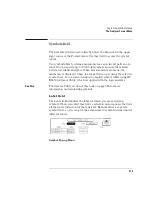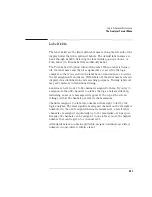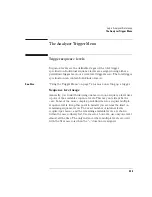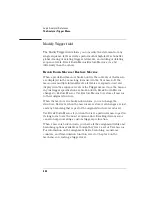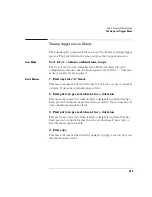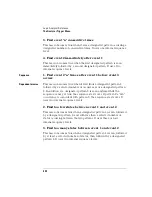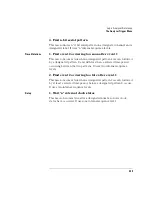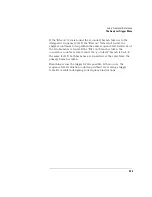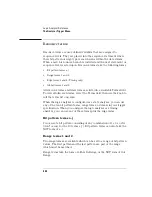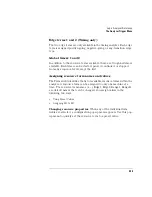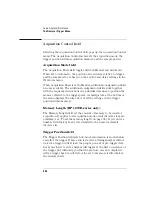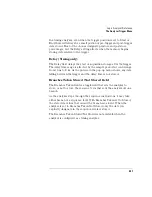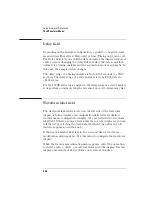
332
Logic Analyzer Reference
The Analyzer Trigger Menu
Using the Occurrence Counters
Occurs field.
When "Occurs" is selected, the < and > duration
functions change to an occurrence counter. Use the occurrence
counter to delay sequence evaluation until the resource term has
occurred a designated number of times. If the "else on" branch
becomes true before all specified occurrences of the primary "Trigger
on" branch, the secondary "else on" branch is taken.
Using the timer
Timers are like other resource terms in that they are either true or
false. Timers can be set to Start, Stop, Pause, or Continue as the
analyzer enters a sequence level. The two timers are global, so each
sequence level can control the same timer. The default timer condition
in all sequence levels is Off.
Timers start as you enter the sequence level, and when the timer count
expires, the timer becomes true. If a timer is paused in one level, it
must be continued in another level before it can count through.
As more sequence levels are added, the timer status in the new levels
defaults to Off. Timers must be continued or started in each new level
as appropriate. When a timer expires or stops, its count resets to zero.
Branching
If either the less than or greater than duration is used, only the primary
branch is available. Otherwise, each sequence level except for the last
has two-way branching.
If the primary branch is taken, the analyzer goes to the next level. If the
primary branch is not found, the analyzer immediately evaluates the
"Else on" secondary branching term.
Summary of Contents for 1670E Series
Page 6: ...6 In This Book...
Page 26: ...26 Contents...
Page 27: ...27 Section 1 Logic Analyzer...
Page 28: ...28...
Page 29: ...29 1 Logic Analyzer Overview...
Page 39: ...39 2 Connecting Peripherals...
Page 49: ...49 3 Using the Logic Analyzer...
Page 72: ...72 Using the Logic Analyzer The Inverse Assembler...
Page 73: ...73 4 Using the Trigger Menu...
Page 101: ...101 5 Using the Oscilloscope...
Page 151: ...151 6 Using the Pattern Generator...
Page 199: ...199 7 Triggering Examples...
Page 237: ...237 8 File Management...
Page 249: ...249 9 Logic Analyzer Reference...
Page 360: ...360 Logic Analyzer Reference The Compare Menu...
Page 361: ...361 10 System Performance Analysis SPA Software...
Page 397: ...397 11 Logic Analyzer Concepts...
Page 430: ...430 Logic Analyzer Concepts The Analyzer Hardware Oscilloscope board theory Oscilloscope board...
Page 439: ...439 12 Troubleshooting the Logic Analyzer...
Page 455: ...455 13 Specifications...
Page 471: ...471 14 Operator s Service...
Page 479: ...479 Operator s Service Troubleshooting Troubleshooting Flowchart 2...
Page 491: ...491 Section 2 LAN...
Page 492: ...492...
Page 493: ...493 15 Introducing the LAN Interface...
Page 497: ...497 16 Connecting and Configuring the LAN...
Page 506: ...506 Connecting and Configuring the LAN Connecting and Configuring the LAN...
Page 507: ...507 17 Accessing the Logic Analyzer File System Using the LAN...
Page 515: ...515 18 Using the LAN s X Window Interface...
Page 527: ...527 19 Retrieving and Restoring Data Using the LAN...
Page 539: ...539 20 Programming the Logic Analyzer Using the LAN...
Page 546: ...546 Programming the Logic Analyzer Using the LAN Programming the Logic Analyzer Using the LAN...
Page 547: ...547 21 LAN Concepts...
Page 555: ...555 22 Troubleshooting the LAN Connection...
Page 580: ...580 Troubleshooting the LAN Connection Getting Service Support...
Page 581: ...581 Section 3 Symbol Utility...
Page 582: ...582...
Page 583: ...583 23 Symbol Utility Introduction...
Page 588: ...588 Symbol Utility Introduction Symbol Utility Introduction...
Page 589: ...589 24 Getting Started with the Symbol Utility...
Page 597: ...597 25 Using the Symbol Utility...
Page 609: ...609 26 Symbol Utility Features and Functions...


